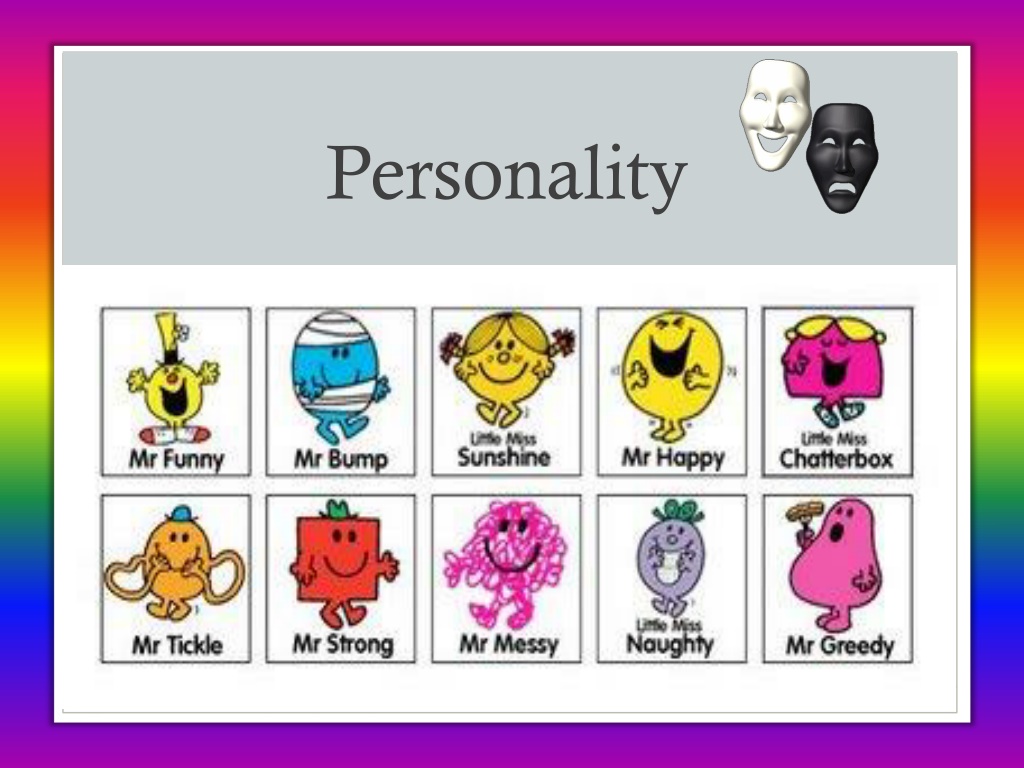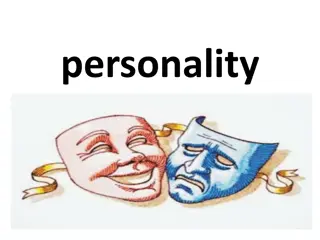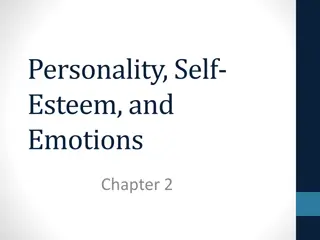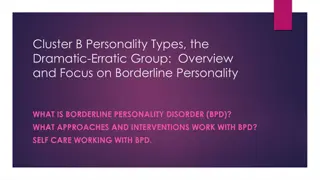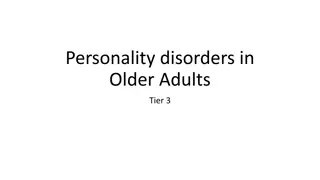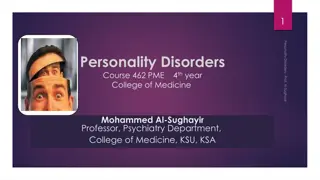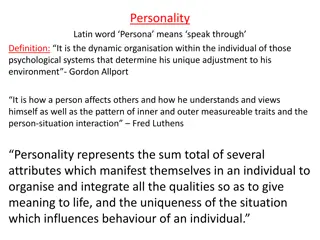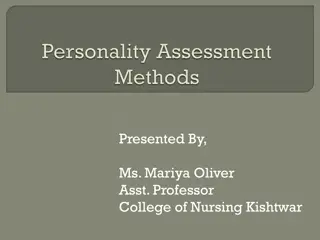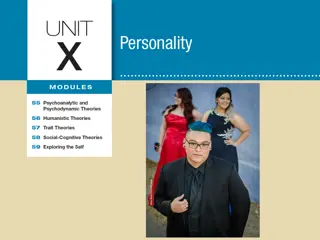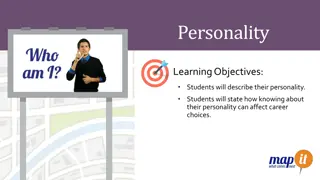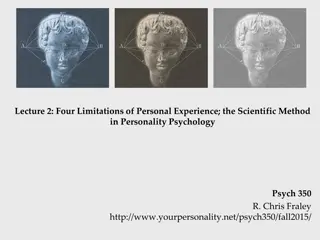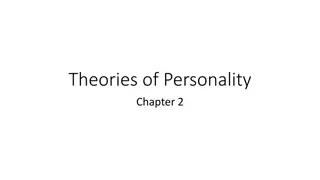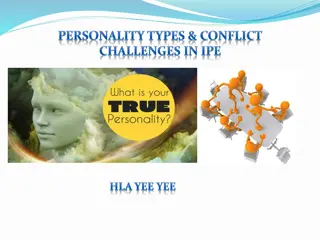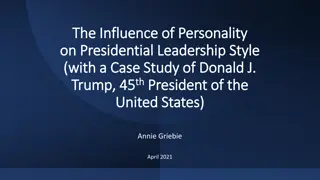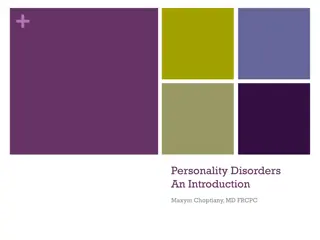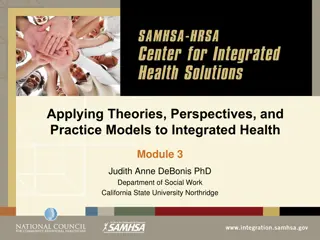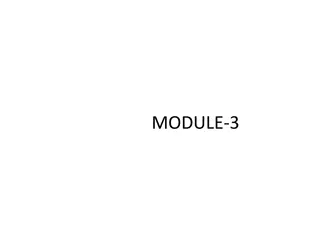Understanding Personality: Theories, Types, and Assessment
Exploring the intricate world of personality, this comprehensive guide delves into major theories of personality development, assessment methods, cultural influences, and key contributors. Discover the different types of personalities, including Type A and Type B, and unravel the complexities of psychodynamic, humanistic, and social-cognitive theories. Gain insights into how our individual traits shape our behaviors and interactions with the world around us.
Download Presentation

Please find below an Image/Link to download the presentation.
The content on the website is provided AS IS for your information and personal use only. It may not be sold, licensed, or shared on other websites without obtaining consent from the author. Download presentation by click this link. If you encounter any issues during the download, it is possible that the publisher has removed the file from their server.
E N D
Presentation Transcript
AP Exam Personality (5 7%) In this section of the course, students explore major theories of how humans develop enduring patterns of behavior and personal characteristics that influence how others relate to them. The unit also addresses research methods used to assess personality. AP students in psychology should be able to do the following: Compare and contrast the major theories and approaches to explaining personality (e.g., psychoanalytic, humanist, cognitive, trait, social cognition, behavioral) Describe and compare research methods (e.g., case studies and surveys) that psychologists use to investigate personality. Identify frequently used assessment strategies (e.g., the Minnesota Multiphasic Personality Inventory [MMPI], the Thematic Apperception Test [TAT]), and evaluate relative test quality based on reliability and validity of the instruments. Speculate how cultural context can facilitate or constrain personality development, especially as it relates to self-concept (e.g., collectivistic versus individualistic cultures). Identify key contributors to personality theory (e.g., Alfred Adler, Albert Bandura, Paul Costa and Robert McCrae, Sigmund Freud, Carl Jung, Abraham Maslow, Carl Rogers).
Personality Personality: The psychological qualities that bring a consistency to an individual s thoughts and behaviors in different situations and at different times. Personality is a continuously changing process, shaped by our individual needs and cognitions and by external pressures from the social environment. It is the thread that consistently runs through our lives.
Types of Personalities Type A Type B Feel time pressure. Relaxed and easygoing. Easily angered. But some people fit in neither type. Competitive and ambitious. Work hard and play hard. More prone to heart disease than rest of population.
Main Theories Psychodynamic Theory: Freud s theory that calls attention to motivation, especially unconscious motives, and the influence of our past experiences. Humanistic Theory: A theory that emphasizes the present, subjective reality-what we believe is important now, what we think of ourselves in relation to others is important now. Social-cognitive theory : derived from experiments in psychology rather than clinical work. This theory is based on the idea that personality is a result of learning, perception and social interaction. Despite what it seems, social-cognitive theory and clinical perspective compliment each other and share some common ideas.
Clinical Perspective The clinical perspective utilizes a combination of the psychodynamic and humanistic theories. This is most often used by psychologists who are working with people who are seeking counseling.
Psychodynamic Theories Although there are a variety of psychodynamic theories, they originate with Freud s psychoanalytic theory. In this theory, Freud said the unconscious, the hidden parts of the mind, was a source of powerful impulses, instincts, motives, and conflicts that energize personality.
Psychodynamic Theory Freud s psychodynamic theory developed in the early 1900s grew out of his work with patients. Freud used the term dynamic to refer to mental energy force. It emphasizes the importance of early childhood experiences, unconscious or repressed thoughts that we can t voluntarily access, and the conflicts between conscious and unconscious forces that influence our feelings, thoughts, and behaviors.
Psychoanalysis Psychoanalysis focuses on how the mind s energy is exchanged, transformed and expressed. The mental stream of the sex drive was called the Eros, he Greek god for passionate love. The energy behind this drive was called libido, Latin for lust. The mental stream for destruction was Thanatos. Freud called it the death instinct that drives aggressive and destructive acts humans commit against each other.
Psychodynamic Theory Conscious thoughts: are wishes, desires, or thoughts that we are aware of or can recall at any given moment. Preconscious- things we can be aware of if we think of them. Unconscious forces: represent wishes desires, or thoughts that because of their disturbing/threatening content, we automatically repress and cannot voluntarily access. Freud believed that a large part of our behavior was guided or motivated by unconscious forces.
Psychodynamic Theory Unconscious motivation: is a Freudian concept that refers to the influence of repressed thoughts, desires, or impulses on our conscious thoughts and behaviors.
Techniques to Discover the Unconscious Freud developed three methods to uncover unconscious processes: free association, dream interpretation, and slips of the tongue (Freudian slips). Free association: Freud encouraged clients to talk about any thoughts or images that enter their head; the assumption is that this kind of free- flowing uncensored talking will provide clues to unconscious material.
Techniques to Discover the Unconscious Dream Interpretation: a Freudian technique of analyzing dreams, is based on the assumption that dreams contain underlying, hidden meanings and symbols that provide clues to unconscious thoughts and desires. Freud distinguished between the dreams obvious story or plot, called manifest content, and the dream s hidden or disguised meanings or symbols, called latent content.
Techniques to Discover the Unconscious Freudian Slips: are mistakes or slips of the tongue that we make in everyday speech; such mistakes which are often embarrassing, are thought to reflect unconscious thoughts or wishes. 51RUKuSeDgL Video: http://www.youtube.com/watch?v=uxWoNBWD0v4&list=PL7A30288C511D4EDD
Techniques to Discover the Unconscious Freud assumed that the 3 techniques are all mental processes that are the least controlled by our conscious, rational, and logical minds. As a result, he believed that these 3 techniques allowed uncensored clues to slip out and reveal our deeper unconscious wishes and desires.
Psychodynamic Theory To understand how the id, ego, and superego interact, imagine an iceberg floating in the sea. The part of the iceberg that is above water represents conscious forces of which we are aware, while parts below the water indicate unconscious forces of which we are not aware.
The Id In Freud s model, the id is the primitive, unconscious reservoir that houses the basic motives, drives and instinctive desires that determine our personalities. Always acts on impulse and seeks immediate pleasure The only part of the personality present at birth 2 biological drives- sex and aggression Source of all mental energy. The id follows the pleasure principle, which is to satisfy the drives and avoid pain, without concern for moral restrictions or society s regulations.
The Ego Regulating the conflict between the id and the superego is the job of the ego-the conscious, rational part of the mind. The ego must figure out a way to satisfy one s desires, while not violating one s moral code. When this balance becomes upset, conflicted thoughts and behaviors that signify a mental disorder may be the result The ego follows the reality principle, which is to satisfy a wish or desire only if there is a socially acceptable outlet available. The ego develops from the id during infancy.
The Superego The superego is the police of personality and is responsible for morals and values learned from society. The superego develops as the the child forms an internal set of rules based on external experiences The inner voice of shoulds and should nots Often conflicts with the id because the id wants what feels good and the superego wants what is right and moral The superego develops from the ego during early childhood.
Psychodynamic Theory Disagreements? Freud believed that often times there is little to no disagreement between the goals of the id and superego. However, when disagreement occurs Freud theorized that the ego works to find compromise between the goals of the id an superego. This compromise is found by the ego using what Freud described as mental processes or defense mechanisms.
Defense Mechanisms Defense mechanisms are Freudian processes that operate at unconscious levels and that use self-deception or untrue explanations to protect the ego from being overwhelmed by anxiety. Anxiety: an uncomfortable feeling that results from inner conflicts between the primitive desires of the id and moral goals of the superego.
Defense Mechanisms Rationalization: involves covering up the true reasons for actions, thoughts, or feelings by making up excuses and incorrect explanations. Denial: is refusing to recognize some anxiety provoking event or piece of information that is clear to others. Repression: involves blocking and pushing unacceptable or threatening feelings, wishes, or experiences in the unconscious.
Defense Mechanisms Projection: falsely and unconsciously attributes your own unacceptable feelings, traits, or thoughts to individuals or objects. Reaction Formation: involves substituting behaviors, thoughts, or feelings that are the direct opposite of unacceptable ones. Displacement: involves transferring feelings about, or response to, an object that causes anxiety to another person or object that is less threatening. Sublimation- Channeling one s frustration toward a different goal. Sometimes a healthy defense mechanism.
Defense Mechanisms Note that all these defense mechanisms function indirectly and unconsciously. They reduce anxiety by disguising our threatening impulses. Just as the body unconsciously defends itself against disease, so also, believed Freud does the ego unconsciously defend itself against anxiety.
5 Psychosexual Stages Analysis of his patients histories convinced Freud that personality forms during life s first few years. Again and again his patients symptoms seemed rooted in unresolved conflicts from early childhood. He concluded that children pass through a series of psychosexual stages, during which the id s pleasure seeking energies focus on distinct pleasure-sensative areas of the body called erogenous zones.
5 Psychosexual Stages Freud s Psychosexual Stages Stage Focus Oral Pleasure centers on the mouth-- (0-18 months) sucking, biting, chewing Anal Pleasure focuses on bowel and bladder (18-36 months) elimination; coping with demands for control Phallic Pleasure zone is the genitals; coping with (3-6 years) incestuous sexual feelings Latency Dormant sexual feelings (6 to puberty) Genital Maturation of sexual interests (puberty on)
Psychosexual Stages Freud believed that our early experiences stayed with us and affected us throughout our development, especially with regards to sex. Should something happen in the early years, people will have problems to overcome later in life specifically dealing with sexuality: Oedipus complex: boy in love with their mother Identification: boys in love their mom/identify with their dad Penis envy: girls desire to have a penis-attracted to males Fixation: occurs when development is stopped at a particular stage
Ego Defense Ego defense is the largely unconscious mental strategy to reduce anxiety or conflict. Repression: the ego defense that excludes unacceptable or inappropriate thoughts and feelings from our awareness.
Assessing the Unconscious Projective Test a personality test, such as the Rorschach or TAT, that provides ambiguous stimuli designed to trigger projection of one s inner dynamics Thematic Apperception Test (TAT) a projective test in which people express their inner feelings and interests through the stories they make up about ambiguous scenes Their answers reveal the Manifest content. They can then discover the Latent Content.
Assessing the Unconscious Rorschach Inkblot Test the most widely used projective test a set of 10 inkblots designed by Hermann Rorschach seeks to identify people s inner feelings by analyzing their interpretations of the blots
Criticism of Freud While Freud is still wildly popular in media and culture, it has lost most of it support in the psychology field. Many Freudian concepts (libido, repression) are vague The focus is on retrospective explanation Only looks back, doesn t give credit to the present or future No thought given to women The unconscious mind is not as smart/purposeful as Freud would like us to believe
Neo-Freudians Freud was a controversial figure, and many of his collogues broke away from his view, but still maintained a psychodynamic aspect to their theories Alfred Adler importance of childhood social tension Karen Horney sought to balance Freud s masculine biases Carl Jung emphasized the collective unconscious concept of a shared, inherited reservoir of memory traces from our species history .
Freuds Followers and Critics Carl Jung: Jung originally a close friend and follower of Freud disagreed with Freud's emphasis on the sex drive. Jung believed the collective unconscious-and not sex-to be the basic force in the development of personality. The collective unconscious, according to Jung, consists of ancient memory traces and symbols that are passed on by birth and are shared by all peoples in all cultures.
Freuds Followers and Critics Alfred Adler: like Jung was originally a friend and follower of Freud s but he disagreed with his theory that humans are governed by biological and sexual urges. Adlerbelieved that the main factors influencing a child s development were sibling influences and child-rearing practices. Adler proposed that humans are motivated by social urges and that each person is a social being with a unique personality. http://die-psychotherapie-ausbildung.de/medien/bilder/Module-Seminare/Tiefenpsychologie/Alfred-Adler-340px.jpeg In contrast to Freud s emphasis on unconscious forces that influence our behaviors, Adler suggested that we are aware of our motives and goals and have the capacity to guide and plan our futures.
Freuds Followers and Critics Karen Horney: never a follower of Freud strongly objected to his view that women were dependent, vain, and submissive because of biological forces and childhood sexual experiences. She especially took issue with Freud s idea that penis envy affected girls development. Horney insisted that he major influence on personality development can be found in child-parent social interaction.
Humanistic Theories Humanistic theories are optimistic about the core of human nature. Personality is driven by needs to adapt and learn, rather than unconscious conflicts or defense mechanisms and anxiety Mental disorders occur when a person is in an unhealthy situation that causes low self-esteem and unmet needs, not from unhealthy individuals.
Abraham Maslow The most famous humanistic perspective came from Abraham Maslow who created a hierarchy of needs (chapter 8). He said we needed something that described good mental health as more than just the absence of illness. Maslow saw a group of people in pursuit of higher ideals and wanted a way to explain their behavior. Self-actualizing personalities-healthy individuals who have met their basic needs and are free to be creative and fulfill their potentialities.
Maslows Heirarchy of Needs It arranges needs in ascending order with biological needs at the bottom and social and personal needs at the top. Only when needs at a lower level are met can we advance to the next level.
Maslows Heirarchy of Needs Deficiency needs are physiological needs (food, sleep) and psychological needs (safety, love, esteem) that we try to fulfill if they are not met. Growth needs are those at the higher levels and include the desire for truth, goodness, beauty and justice.
Maslows Heirarchy of Needs According to Maslow, we must satisfy our deficiency needs before having the time and energy to satisfy our growth needs and move toward self- actualization. Self-actualization: refers to the development and fulfillment of one s unique human potential
